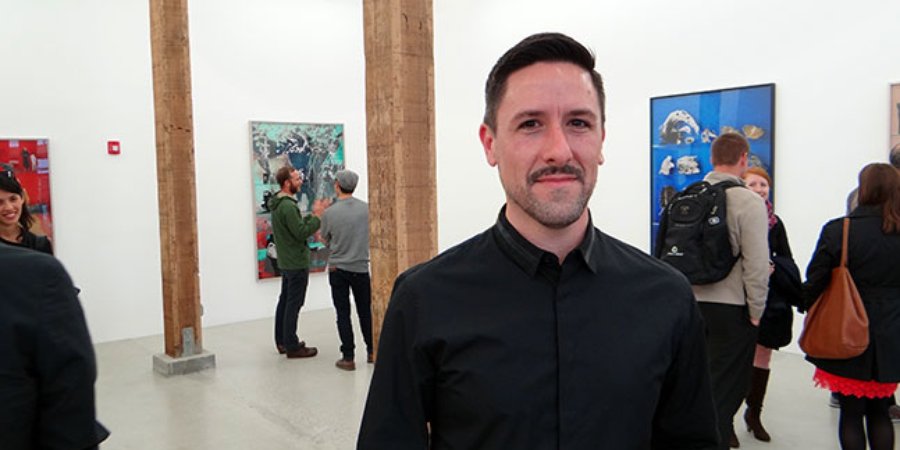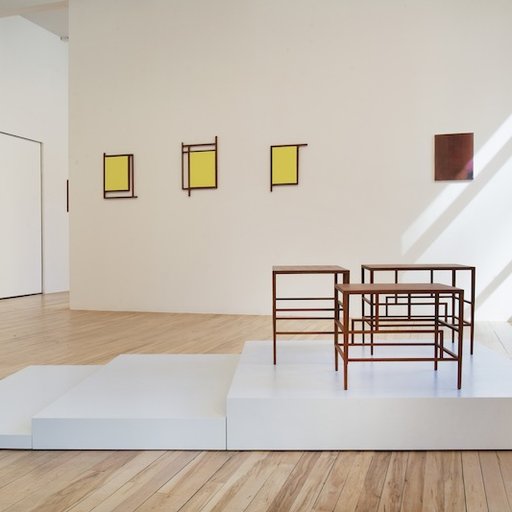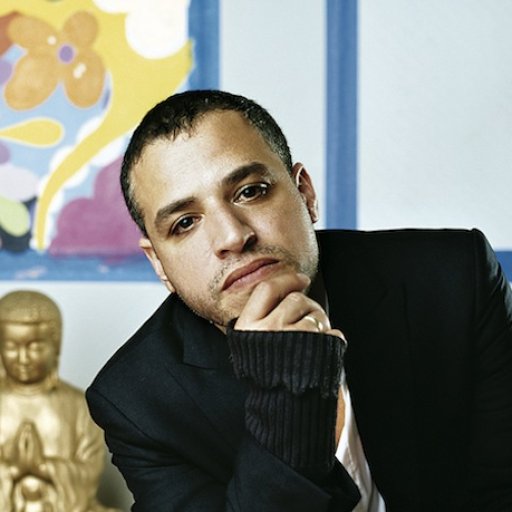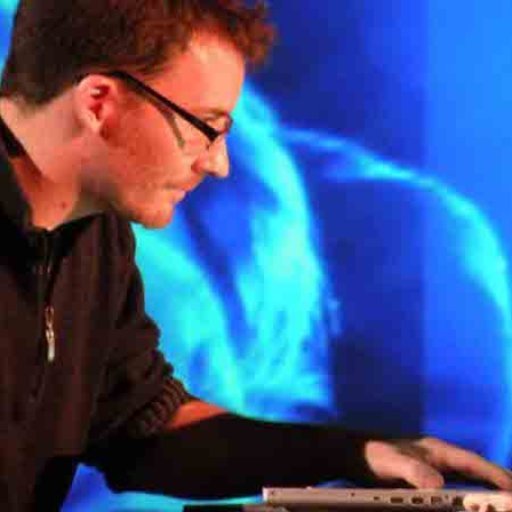If photography has not yet been completely dematerialized, it's on its way to that point. To belabor this fact is to beat a dead horse. But the conversation surrounding photography's mutation into a digital medium tends to focus on the recent past—the time after the introduction of digital alternatives to what were once analog processes—at the risk of ignoring how photography has always been concerned with reproduction, seriality, and taxonomy.
For the past decade, San Francisco-based artist
Matt Lipps
has made curious hybrid photo-sculptures that simultaneously catalogue, lament, and celebrate photography's radical 21st-century transformations. Lipps creates large-scale "stages" for cutout elements of images from old photography publications—some of them recognizable as the iconic photos or images of well-known artworks; others are family portraits or other anonymous snapshots—which he arranges in three-dimensional arrays and then re-photographs. The resulting prints combine sculpture, collage, assemblage, and
Pictures Generation
-style seriality.
Using this methodology, Lipps has created a new series of works for his current show at
Jessica Silverman Gallery
in San Francsico that undercut the fetishism surrounding the digital image's capacity for duplication and metamorphosis. Using materials taken from amateur photographers' how-to manuals from the 1970s, Lipps make the case that the supposedly Internet-derived, algorithmic image culture so widespread today may actually find its roots in the feverish popularity of the low-cost Brownie camera of the 1950s and the ubiquitous Fujifilm disposable point-and-shoot of the '80s.
We spoke with Lipps via email about revisiting work from his student days, the photograph as a "window or mirror," and sourcing photos from books rather than Google.
Your newest series of photographs, on view at Jessica Silverman Gallery in San Francisco, includes backdrops that come from pictures that you took as a student in high school and during your undergraduate work. What made you revisit your old photographs in this way?
I suppose I’ve always been more interested in looking back than looking forward. In this instance, I decided to revisit my own archive of 35mm black-and-white negatives from early on in my personal history with photography. It was equally inspired by teaching chemical black-and-white photography to students whose age I would have been while exposing those early negatives, and by Library of Photography , the 17-volume compendium published and distributed by Time Life Inc. that provides the source material for all the cutout elements staged in my own Library series.
Library of Photography
was started in 1970. They are silver, square books with beautiful reproductions each illustrating a different genre or process found in black-and-white and color chemical photography. They were non-hierarchical and instructional—you could find how to mix chemistry, how to take a photographic portrait of your child, studio lighting techniques, profiles on fine art photographers, and more. It seems they were aimed at capitalizing on a moment in history when every family in the U.S. and abroad was purchasing their first 35mm SLR cameras and setting up home darkrooms. They provide an invitation to begin utilizing this new technology, capturing life around them and contributing to their own grand narratives.
Did you come across the
Library of Photography
in your own training as a photographer?
I didn’t learn photography from these volumes, but I certainly was trained in the manner of them and encouraged to follow in their footsteps. It would appear I was engaging in appropriation years before I was actually engaged in the conceptualized practice of appropriation simply by reviewing my earliest portfolio and being able to identify
my
version of an
Irving Penn;
my
Walker Evans
;
my
Ansel Adams
;
my
Aaron Siskind
; and so on, by how successfully—or not—I could emulate them.
This body of work is about looking back at how this particular book series helped to define these distinct genres across the broad landscape of this thing we call photography—especially from a contemporary viewpoint when our relationship to “images” is so intimate and intertwined with every aspect of our daily lives.
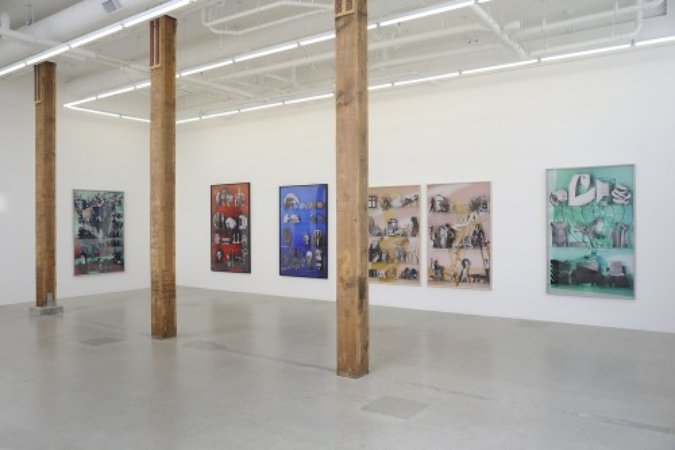
The show also uses what are referred to in the press release as "theater staging techniques"—in other words, you treat the frame of the photograph as a theater's proscenium, with the individual cutout collage elements playing the part of actors on a stage. How much does a sense of narrative or dramatic effect inform your work?
My process is manifold. It starts with me cruising the pages of the individual books and responding to the different images. From there, I elect to cut out certain fragments of images to be backed with cardboard and made to stand up as a paper doll figure—a moveable actor to be mobilized among other characters from the book. The forms stand on glass shelves that are set up against a colorful photographic background—again, one of my early black-and-white negatives that has been colorized in Photoshop to make the forms stand out in contrast. The cast is moveable and the compositions are equally intuitive and, at moments, directed to elicit loose narratives, humorous juxtapositions, and surprising coincidences. I then re-photograph the entire still life of characters, shelves, and backdrop to lock the players back under a seamless photographic veneer. In the end, I don’t aim to offer up a narrative to be decoded, but rather to examine all the parts at once and to place them in constellation with one another on a common ground.
Do you think of your work as being figurative or abstract?
I suppose both—or, neither—depending on how you define the terms. I’ve always spoken about my practice as being “with photography.” My earlier photographs were motivated by a desire to be
with
the figures in the magazines. The project was about desire as seen and experienced through the camera and on the surface of the photographic print. I think that’s a pretty abstract notion for some people to understand, perhaps. The work has since expanded beyond my initial impulse, and I’ve been thinking for some time about the many different relationships we have to photographs both personal and public. With
Library,
I was surprised to find the content had shifted towards history itself, specifically our collective, shared relationship to history and memory experienced through the apparatus of photography.
When thinking about the metaphor of photographs as being either “windows" or "mirrors,” I think my work is so much about the surface of the photographic façade that it allows and denies both in an interesting way. In that regard, I could see how they are read in fairly abstract terms because my photographs don’t really allow for the pictorial pleasure that photographs traditionally promise—even though they participate in the tradition of still life photography, or photographs of objects displayed in studio space, in a very direct way.

You've said before that people play games with the work, where it becomes an experience of trying to identify the source photographs. Do you think of your work as responding to specific conditions of viewership in contemporary art of the present moment?
I’m not certain if the conditions of viewership are specific to contemporary art, so much as it’s merely a condition of the image-saturated culture we participate in—which is a wonderfully mind-numbing thing for someone like me to inhabit. Especially having been born prior, and coming of age during the advent of the Internet. I’m definitely noticing a generational difference in the way I relate to photographs that seems markedly different than my student’s experience.
What I like about the games people play with the photographs from the
Library
series is that all of the images predate me, having been born in 1975, but they are known to me from museums, history books, Internet research, and popular culture. And, for many viewers, they too recognize a great many images, though the specifics surrounding the image and it’s importance might escape them. But, what also happens is that many people
think
they know an image, or they may recall a handful of images that might be the one cutout element they’re seeing—and all of those images get indexed into the meaning of that one individual photograph. In other words, the elements function as prompts for many photographs that you already “know” from personal snapshots, popular photography, and historical references.
Could you explain the thematic or hierarchical division of the images in your work? In the
HORIZON/S
series, for example, which is divided into "Public Collections" and "Private Collections"; or the grouping of images in
The Populist Camera
into groups like "Perspective," "Travel," and "Children"?
I think a lot of artists working in photography bear the burden of “seriality.” So, I’ve been working in series of photographs for the last four or five projects, taking at least a year or two to produce all the parts and craft the look for each. While all the work is similar in vocabulary—using cut-out fragments of other photographs and restaging them—I do have different interests in the materials I source. For
HORIZON/S
and
Library ,
the name of the series shown in
The Populist Camera
at Jessica Silverman, I took my starting point from book sets that were designed as home subscriptions for families in the U.S. aimed at teaching themsomething about high culture and fine art, or photography.
HORIZON/S
was split into two categories, “Public Collections” and “Private Collections,” because along the way in that project I deviated from my original idea and wanted to make a few more photographs that worked slightly differently from the original. In that series I was testing the logic of traditional modes of organizing and understanding the vast, sprawling production of global arts and culture—the premise of
Horizon Magazine
. By “curating” these group portraits of unlikely matched objects I was hoping to see what other kinds of logic could be found and other brands of meaning could be produced. At a certain point, I got off track and made a couple of photographs that I was feeling compelled to make—they didn’t fit the same “curatorial premise,” rather they spoke more about an individual taste, more like a private collection—hence the split.
In
Library,
I chose to work with the images from the
Library of Photography
book set. Right away I knew I was going to make one photograph for each volume in the series—there were 17 volumes, each with their own theme, and I made 17 photographs. The series was followed up with a short-lived “best of” annual from 1973-1975, which I decided to make into one photograph, a triptych compiling the best of all three years into one picture. So, for example, the photograph
Travel
is constructed from images found in the book dedicated to the subject and in dialogue with my colorized backdrop photograph. Stripped of caption and text, here they are presented together and referencing a multitude of images that can all be tied back to this thing we call “travel photography.”

In a way, it almost seems as though your work implies that the idea of a "remix culture" or an internet-specific experience of images is actually something that reaches much farther back, before the invention of the internet and digital technology—especially because the kind of photographs you make, which could easily be done in Photoshop on a computer, is done through a very physical process, by hand. Is this a fair reading of the work, and how important is your physical process to you?
My process is very important to you me—it’s the way I relate to images and it’s born out of a logic that predates all of my artwork. I started making cut-out paper dolls when I was a teenager. It wasn’t until I was in graduate school while teaching myself how to use a 4x5 film camera that I started taking photographs of them and making enlargements. It completely changed what a photograph is to me, and helped me define my relationship to images. Now, 10 years later, I can see perhaps how the Internet has influenced the structuring of my photographs—there is a quality of Google Image Search about the work that delivers so many references to you at once.
I remember when I first “surfed the Web” in college, and I never could have imagined how integrated it’s become in everything I do. But I was raised before the Internet and had a very analog childhood. I learned photography from books, and it’s comforting to return to them. Anecdotally, in college I worked as a digital restoration artist, using Photoshop to rebuild customer’s damaged photos. So, I could technically have done this all in the computer—though, I think it would have been
more
difficult for me than doing it with an X-acto blade. But, the physical process of cutting things out and seeing what happens when they’re reanimated and set alongside other images is my interest. It’s a way of being
with
photographs that most others don’t consider, and even I can’t imagine what’s going to happen until I see it.
You also teach at San Francisco State University. Has being a teacher affected the way you work at all, especially as you've revisited your own student work?
I’m finding the more I’m engaged to discuss this work, the more and more I end up referencing a way of working in photography when things were unadulterated and new. This book series comes at photography from that point of view, I think. Certainly, when I first started working in photography, I was absolutely fascinated by learning to see photographically and taking slices of life from the world around me and making them into images. My students, who have grown up surrounded by digital imaging, probably having access to digital imaging devices from a much earlier age than me, have been seeing photographically from the onset.
I’m not sure I’m able to articulate the difference, but there is a mix of learning and unlearning in my classroom in order to make photographs that resonate in an art context. Especially when students who were raised in digital imaging are asked to take an analog black-and-white chemical photography class—it introduces so many variables, unknowns, and magic back into the equation. Magic, that I remember from my first classes in high school photography, and that I’m happy to report
still
happens in darkrooms today with my students.

How do you know when a series of photographs is finished?
I think that’s a question for all artists, and it can even be made of each individual artwork. There is a place of resolve or satisfaction—hopefully—with what’s been accomplished. In my works, I think I start with an exploration of ideas or questions that eventually get exhausted and I resign myself to step back and see what, if any, conclusions can be drawn. I imagine it’s much like a conversation: hopefully everyone recognizes its conclusion, everyone is thanked for having shared time, exchanged ideas, and each goes their own way.











